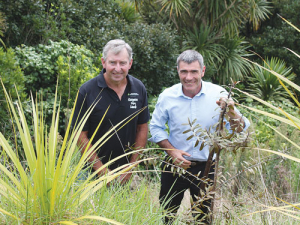MPI launches industry-wide project to manage feral deer
An industry-wide project led by Ministry for Primary Industries (MPI) is underway to deal with the rising number of feral pests, in particular, browsing pests such as deer and pigs.
 Ballance Environmental farmer of the Year Richard Kidd, with Primary Industries Minister Nathan Guy who planted a kauri on Kidd’s farm.
Ballance Environmental farmer of the Year Richard Kidd, with Primary Industries Minister Nathan Guy who planted a kauri on Kidd’s farm.
An OECD report missed a critical point in claiming NZ is reaching its environmental limits and criticising the government’s primary export targets.
So says Primary Industries Minister Nathan Guy.
The critical thing they missed is the government’s target of doubling the value – not the volume -- of primary exports by 2025, Guy says.
“There is no way we can increase our dairy cow numbers from 5 million to 10 million – we can’t do that,” he explained. “There is no way we can catch twice the amount of fish in our oceans. [The aim is] value creation.”
Guy says he met the people writing the report last year, when they visited MPI staff. They then wrote a report challenging the primary sector.
“Yes we do have challenges…. We will work constructively with regional councils on a catchment by catchment basis,” he says. “We will look at the challenges in Waikato, and in the rivers in Canterbury…. we need to get the limits set right.”
Water quality is important foraNZ, hence the government’s policy of making our rivers swimmable by 2040, he says.
“Currently 72% are swimmable; we’ve made a target of 90% and we know that will be a stretch. We will talk to farmers about managing E.coli; that will require fencing about 56,000km alongside waterways.”
Dairy and other farms have come a long way voluntarily. The dairy industry has fenced 24,000km of waterways to exclude livestock. “A lot of those have riparian planting done voluntarily over about a decade.”
Now MPI is talking to red meat, beef, deer and pig farmers, Guy says. This will cost about $370m over the next 13 years, some $200 million of that for water reticulation on farms. Farmers fencing cattle out of rivers and streams will have to tap into streams or springs to supply tanks and troughs.
A recent MPI report on water supply on hill country farms shows the cost of water reticulation is recouped over three years.
“You don’t get good grazing performance on hill country unless you put crops in strategic places and then you have the opportunity to lift your overall productivity,” Guy says.
Meat processors are hopeful that the additional 15% tariff on lamb exports to the US will also come off.
Fears of a serious early drought in Hawke’s Bay have been allayed – for the moment at least.
There was much theatre in the Beehive before the Government's new Resource Management Act (RMA) reform bills were introduced into Parliament last week.
The government has unveiled yet another move which it claims will unlock the potential of the country’s cities and region.
The government is hailing the news that food and fibre exports are predicted to reach a record $62 billion in the next year.
The final Global Dairy Trade (GDT) auction has delivered bad news for dairy farmers.

OPINION: The release of the Natural Environment Bill and Planning Bill to replace the Resource Management Act is a red-letter day…
OPINION: Federated Farmers has launched a new campaign, swapping ‘The Twelve Days of Christmas’ for ‘The Twelve Pests of Christmas’ to…